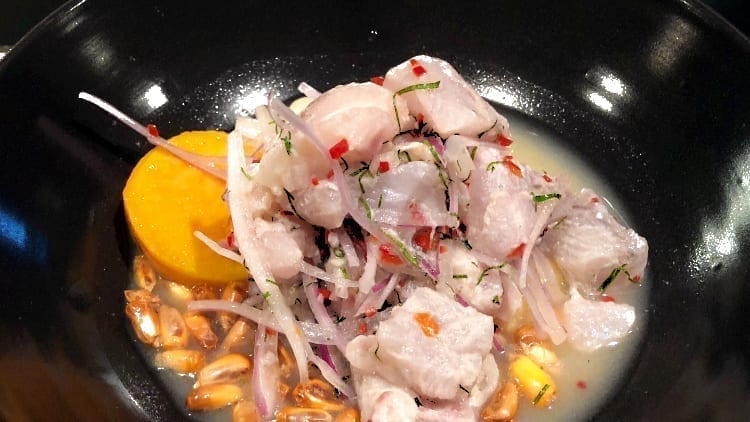Galápagos – choice anxiety?
Island hopping or cruise expedition? Are this ship and this route actually the best choice? This article tells you what to look for when choosing the right trip ...

When you are traveling to Peru or Ecuador, it will be hard to miss: Ceviche (or locally Cebiche). In its simplest form, a dish in which fish is “cured” in a citrus marinade (for example lime juice) and chili peppers. The dish has many variations, using various types of fish and the addition of multiple ingredients. In addition, nowadays also vegetarian ceviches are served, or meat dishes prepared with the same cooking technique.
In Peru, the ceviche has been declared a national dish and since 2008 people have even celebrated the “Día Nacional de Cebiche” each year on June 28. Although Ecuador has not declared a national holiday to honor the dish, the love of the Ecuadorians for this delicious meal is no less. There are even voices claiming that the origins of ceviche may lie in Ecuador. The preparation in both countries is completely different and therefore the perfect starting point for a great rivalry between the two nations. Talk to a Peruvian about the fantastic ceviche you have eaten in Ecuador and he will look at you with pity. If you tell an Ecuadorian that you like the ceviche in Peru better, he will roll his eyes in disbelief and will preferably want to take you to a local restaurant to prove the opposite.
Martin Morales writes in his book “several thousand years ago, people in the coastal regions of Peru ate a variation of the contemporary classic ceviche. I think the fishermen braving the seas knew they could easily feed themselves with some freshly caught fish made with the Peruvian amarillo peppers and the sour juice of the native fruit tumbo.”
The dish we know today as a ceviche is very similar to the dish that was prepared thousands of years ago. It evolved thanks to added ingredients brought to Peru by the Spanish, such as onions and various citrus fruits, especially limes. Depending on the region, various types of fish are used, such as corvina, sea bass or sole. In addition to the lime juice and thinly sliced red onions, the raw, diced fish is prepared with hot peppers (preferably ají amarillo or rocotto), salt and pepper. The dish is served as a salad, often with crispy roasted corn and sweet potato.
The marinade is called Leche de Tigre and is also served as a drink.
When you first order ceviche in Ecuador, you will likely be served something different than you expect. We know this dish outside Latin America, especially in its Peruvian form and the preparation in Ecuador is significantly different. Although many fish species are also used in Ecuador, the most popular variety is the shrimp ceviche. Unlike Peru, the shrimp or fish are not processed raw, but pre-cooked and then served in a bowl with lots of marinade like a kind of cold soup. Here, too, the marinade contains lime and salt. However, the sauce is less spicy than the leche de tigre of its southern neighbors and tomato, pepper and even mustard are added to it, hot peppers are hardly ever used. Popcorn and patacones (crispy fried plantain) complement the dish.
The dishes are so different that it is really a matter of personal taste which one you would feel is better or tastier. Below you will find a recipe from both countries in their most traditional form. Prepare them and see what you think, buen provecho!
Recipe from “Ceviche – Peruvian Kitchen” by Martin Morales (find here)
(appetizer for 4 persons)
Ingredients
Amarillo Chili Leche de Tigre
Ceviche
To make the tiger’s milk: Put the fresh ginger, garlic, cilantro sprigs, and the lime juice in a bowl. Stir and then leave to infuse for 5 minutes. Strain the mixture through a sieve into another bowl. Add salt and amarillo chili paste and mix well. This will keep for 4 hours in the fridge.
To make the ceviche: Rinse the onion and then leave it to soak in iced water for 10 minutes. Drain thoroughly, spread out on a paper towel or a clean kitchen towel to remove any excess water and then place in the fridge until needed. This will reduce the strength of the onion and help to keep the slices crisp.
Cut the fish into uniform strips of around 1 1/4 by 3/4 inch (3 by 2 cm). Place in a large bowl, add a good pinch of salt, and mix together gently with a metal spoon. The salt will help open the fish’s pores. Leave this for 2 minutes and then pour over the tiger’s milk and combine gently with the spoon. Leave the fish to “cook” in this marinade for 2 minutes.
Add the onion, cilantro, chili, and sweet potato to the fish. Mix together gently with the spoon and taste to check that the balance of salt, sour, and chili is to your liking. Divide among serving bowls and serve immediately.
Recipe from “La Cocina del Ecuador” by Mauricio Armendaris
(appetizer for 4 persons)
Ingredients:
Put the onion, lemon and salt in a bowl. Mix well and leave for 7 minutes.
Add mustard, tomato sauce, sodium glutamate, pepper, chili, cilantro and tomato; mix everything thoroughly.
Add shrimp, orange juice and half a cup of the shrimp’s cooking water and mix well again.
Add 3 tablespoons of corn oil and serve immediately with the banana chips.